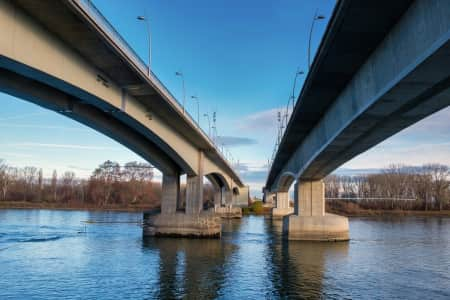Bridges 101: How Bridges Work
Since the beginning of human history, we have wanted to get from “here” to “there”. In some cases, this was a relatively simple task. We used horses, carts, wagons and other animals to make our movement a little quicker. Then we developed trains, planes and automobiles to help us travel farther faster. But no matter the development of transportation methods, the physical geography of the world would always impose some roadblocks. This is where bridges come into play.
What is a Bridge?
A bridge is a structure used to provide a connection between two seemingly unconnected or obstructed points; two sides of land over a body of water, two sides of a deep trench or valley or maybe just to cross a little stream without getting your feet wet.
Bridges also occur in nature. Erosion of rock by water and the collection of logs and stone can create natural bridge formations that may have inspired early homo sapiens to build similar structures.
How Do Bridges Work?
On a very basic level, bridges work by giving us a platform to get from one place or side to the other while avoiding the obstacle or danger between. On a deeper level, however, there is a certain level of science behind how bridges actually work. This applies to modern bridges especially because they traverse larger distances and are expected to carry heavier loads than would have been necessary in the past.
Bridges, in essence, must balance force, gravity and weight to stay standing and to keep people safe when moving across them. The downward force of gravity is balanced out, often, by the bridge itself. Tension and compression created within the shape of the bridge is used to withstand and balance this force.
Image borrowed from Explain That Stuff.
Arch bridges rely mainly on compression to hold weight. Suspension and cable-stayed bridges rely much more on tension to balance gravity and weight. Truss, cantilever and beam bridges lean on a mix of both and the use of shapes to maintain this balance.
These structures need to be able to stand strong under their own weight and also with lots of added weight on top of them. When this balance is not maintained or when the structure becomes corrupted, bridges can fall. Bridge and structure maintenance is really important to prevent this from happening.
The Oldest Bridge Known to Man
Bridges are old.
Archaeologists have found remnants bridges that date back between 1600 - 1300 BC in Greece. The Arkadiko Bridge is another example from the same time period and is the oldest preserved bridge in Europe. A single-arch stone-slab bridge in Turkey dates back to 850 BC. It is still in use today.
These examples only account for bridges we have found. It is entirely plausable bridges have been used even further back in history.
Evolution of Bridges
The concept of bridges has remained the same for thousands of years. The basics of what a bridge is doesn't really change.
Stone bridges were developed in history alongside wooden bridges. Wooden bridges were used both as larger structures and as footbridges for easy walking passage over shorter distances. Remnants of wooden footbridges have been found in Switzerland that date back to 1523 BC, making these structures just as old as stone bridges.
Hanging bridges and suspension bridges are also extremely old. Mentions of hanging bridges date back between 202 BC - 220 AD during the Han Dynasty in China. The Inca in South America have also been using suspension bridges for hundreds of years.
Stone and brick were refined and shaped to create more intricate bridges as technology advanced.
Bridges that move and lift to allow for the passage of ships is one advancement in these structures. Tower Bridge in London England is a famous example of one of these bridges.
The real evolution of bridges comes from the materials used to build them.
Metal Bridges
Because bridges go through changes in compression and tension based on weight, pressure and even weather, flexibility is important. Stone and wood can provide some flexibility but metal is a top choice when balancing strength with durability.
Metal is popular for bridge-building now because it is super malleable. You can shape and form bridge pieces with metal easily. It is less likely to shift and move throughout time, can withstand weather and can carry heavier loads than wood or rock. When metal, iron and steel became more common as building materials, metal bridges followed.
The first cast-iron bridge was built in Shropshire, England in the 18th century. It opened up in 1781. The Brooklyn Bridge was the first steel bridge in the world and opened in 1883. Today, most bridges are built of metal.
Famous Bridges
There are many famous bridges around the world. Their fame often comes from their size, length, design, or how revolutionary they were at the time they were built. Among this list of famous bridges are the Rialto Bridge in Venice, Italy, Tower Bridge in London, England, the Golden Gate Bridge in San Francisco, California and the Danyang-Kunshan Grand Bridge in China.
The Wonder of Bridges
We drive and pass over them every day. Highways, walkways, trains, bikes, walking paths, streets and scenic routes all use bridges to help connect us to where we want to go. Next time you pass over a bridge, think about the history behind it. These simple structures are perhaps one of our closest connections to the history of building.

